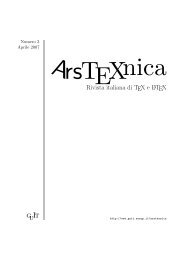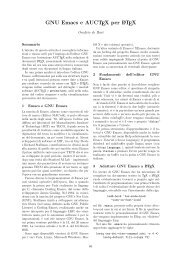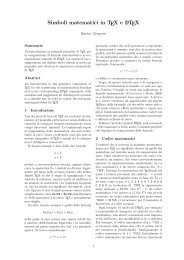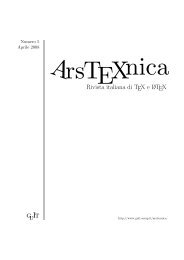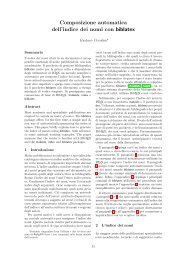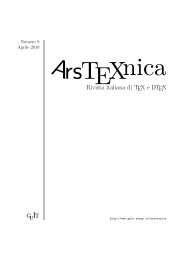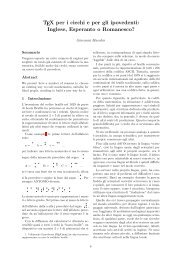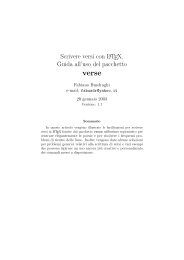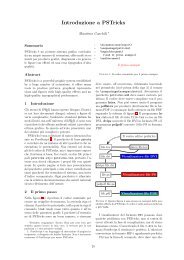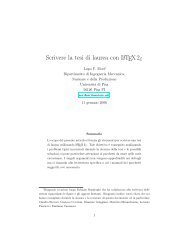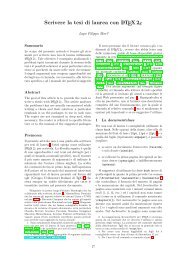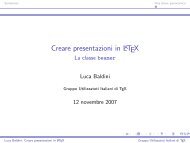Numero 2, 2006 - GuIT - Scuola Superiore Sant'Anna
Numero 2, 2006 - GuIT - Scuola Superiore Sant'Anna
Numero 2, 2006 - GuIT - Scuola Superiore Sant'Anna
Create successful ePaper yourself
Turn your PDF publications into a flip-book with our unique Google optimized e-Paper software.
MlBibT E X’s Architecture<br />
ArsT E Xnica Nº 2, Ottobre <strong>2006</strong><br />
@BOOK{eco1980,<br />
AUTHOR = {Umberto Eco},<br />
TITLE = {Il nome della rosa},<br />
PUBLISHER = {Bompiani},<br />
ADDRESS = roma,<br />
YEAR = 1980,<br />
LANGUAGE = italian}<br />
Notice the LANGUAGE field and language identifier used<br />
to specify this entry for a book written in Italian.<br />
Figure 3: MlBibT E X’s bibliographical entry.<br />
cessing. In other words, that is a kind of ‘benefit<br />
of the doubt’. The commands generating accented<br />
letters and other signs belonging to the Latin 1<br />
encoding are expanded: for example, ‘\’{e}’ is<br />
expanded to the accented letter ‘é’ of this encoding<br />
10 . As a consequence, the accented and special<br />
letters included in the values of MlBibT E X’s fields<br />
are viewed as single letters when entries are sorted.<br />
Besides, this sort operation can be performed w.r.t.<br />
a language’s lexicographical order. The nbst language<br />
provides a nbst:sort element ((Hufflen,<br />
2003, App. A)) that is analogous to the xsl:sort<br />
element of xslt ((W3C, 1999, § 10)): if the data<br />
to be sorted are strings, a language attribute allows<br />
sorting w.r.t. a particular language (English,<br />
Italian, Spanish, . . . )<br />
Likewise, some predefined commands of L A TEX<br />
for fonts (\emph, \textbf, . . . ) are recognised and<br />
expanded to xml elements. This is done by means<br />
of patterns, expressed in Scheme. Now, only some<br />
predefined patterns are processed, e.g.:<br />
(define-pattern "\’e" "é")<br />
(define-pattern "\’{e}" "é")<br />
we plan to extend this capability to user-defined<br />
patterns, so users will be able to mark up their<br />
.bib files, and tell MlBibT E X how it can understand<br />
this markup (Hufflen (2004a)).<br />
During the next step, MlBibT E X deduces the<br />
source .tex file’s name from the .aux file’s 11 . Then<br />
it parses the preamble of this file and try to know:<br />
• which languages are used throughout this document<br />
and how;<br />
• which encoding may be used: pure ascii 12<br />
or Latin 1. So, users can type accented letters<br />
directly inside field values of .bib files<br />
processed by MlBibT E X, even if they do not<br />
use the inputenc package of L A TEX, for dealing<br />
10. Now, most Scheme interpreters can only deal with<br />
the Latin 1 encoding. Future versions should be Unicodecompliant<br />
(Unicode Consortium (2003)) and able to deal<br />
with more encodings, such as Latin 2, UTF-8, . . .<br />
11. You can specify this .tex file’s name by means of an<br />
option of MlBibT E X, if need be.<br />
12. American Standard Code for Information Interchange.<br />
<br />
<br />
<br />
<br />
Umberto<br />
Eco<br />
<br />
<br />
<br />
Il nome della rosa<br />
Bompiani<br />
1980<br />
<br />
<br />
Figure 4: Entry as an xml tree (Fig. 3 cont’d).<br />
with encodings other than ascii ((Mittelbach<br />
et al., 2004, § 7.5.2)). In this last case,<br />
the commands for generating accents will be<br />
used, for example, ‘é’ will be transformed into<br />
‘\’{e}’.<br />
This step results in:<br />
• a list of possible file names 13 whose union is<br />
the multilingual bibliography style;<br />
• updating a set of Scheme functions controlling<br />
MlBibT E X’s output.<br />
Then the files of the bibliography style are<br />
parsed by means of ssax 14 (Kiselyov (2005)).<br />
This parser returns the sxml representation of an<br />
xml tree. So, the result is comparable to the expression<br />
given in Figure 5, but concerns the elements of<br />
a bibliography style. Finally, the fragments of a bibliography<br />
style are assembled and compiled into a<br />
Scheme function 15 (Hufflen (<strong>2006</strong>c)). Then this<br />
function is applied to the list of bibliographical<br />
entries selected.<br />
Last, bibliography styles may use functions written<br />
using the bst language of BibT E X. That allows<br />
‘old’ bibliography styles to be replaced progressively<br />
and explains the arrow, in Figure 2, from<br />
the box concerning bst functions to the box concerning<br />
bibliography styles expressed using the new<br />
language nbst.<br />
3 Conclusion<br />
When we started to develop MlBibT E X’s first version<br />
(Hufflen (2001a)), we only aimed to provide<br />
a ‘better BibT E X’. The only changes from end-users’<br />
13. ‘Possible files’ because some files specific to a particular<br />
language may be inexistent, in which case they are<br />
ignored.<br />
14. Scheme implementation of sax (Simple api for xml).<br />
15. Displaying a function’s body is difficult and often<br />
not provided by most Scheme interpreters, that is why we<br />
do not give more details about this step. But we plan to<br />
develop tools for browsing bibliography styles.<br />
57




